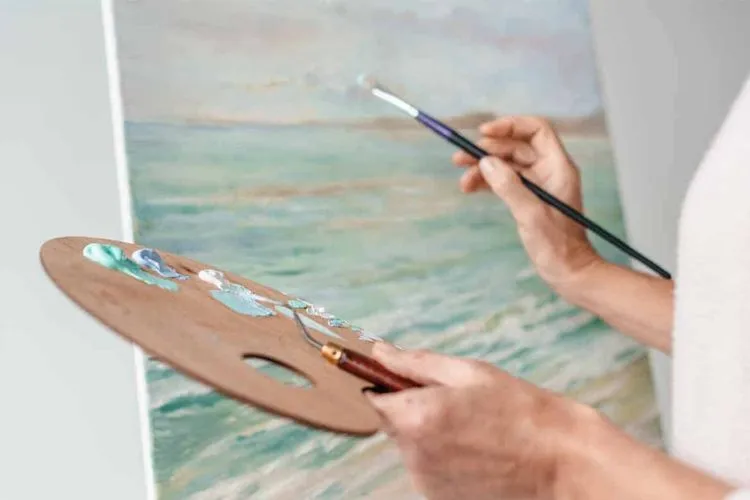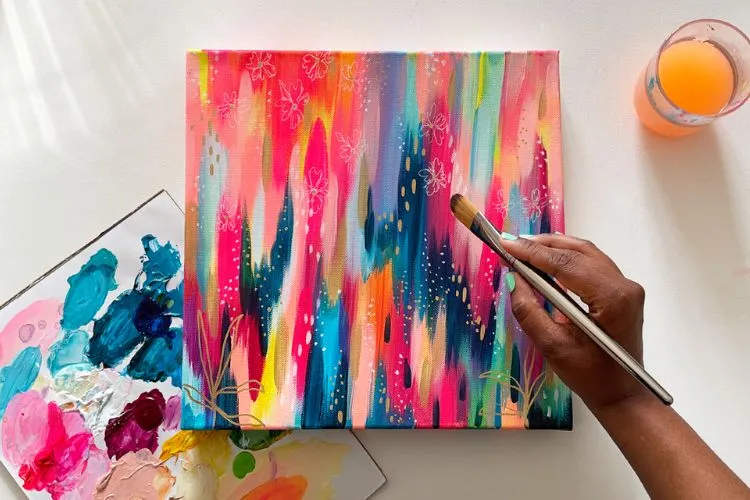Acrylic paint is a preferred medium for many artists due to its versatility, vibrant colors, and quick drying time. However, one common challenge faced by artists is adjusting the paint’s opacity to match their creative vision.
Opacity can significantly impact the visual outcome of a painting. This article serves as a guide to how to make acrylic paint more opaque, enhancing their artwork with the desired coverage and color intensity.

Understanding Opacity in Acrylic Paint
Opacity refers to the covering power of paint — how well it can hide what’s underneath. Transparent paints allow the underlayer to show through, while opaque paints obscure the underlayer completely.
Acrylic paint opacity is influenced by the pigment used, its concentration, and the presence of fillers that manufacturers may add.
How to Make Acrylic Paint More Opaque?
The density of the pigment is a critical determinant of a paint’s opacity. Heavier, denser pigments tend to be more opaque. The quality of the paint also plays a role.
High-quality, artist-grade acrylics usually offer greater opacity than student-grade options due to their higher pigment loads. Additionally, certain colors are naturally more opaque, such as Titanium White and Cadmium Red.
Enhancement of Acrylic Paint Opacity
To enhance the opacity of your acrylic paints, you may start by choosing colors known for their opaque nature. For instance, opting for a Titanium White base can immediately offer better coverage.
Incorporating opaque mediums is another effective strategy. These substances are designed to mix with acrylic paint to increase its thickness and capacity to cover underlying layers without altering the color.
When applying paint, techniques such as dry brushing or stippling can help build up the paint’s opacity. Instead of using sweeping strokes, these methods deposit more paint onto the canvas for a thicker layer, thus increasing opacity.

Pro Tips to Maximize Opacity
In the pursuit of greater opacity, artists should pay attention to how they mix their colors. Over-mixing or adding too much water can result in diluted, less opaque paint.
Preparing your painting surface with a layer of gesso can provide a consistently opaque base, which can significantly improve the opacity of subsequent paint layers.
It’s also important to avoid the use of too much water or adding too much medium, which can reduce your paint’s covering power.
Creating test swatches before applying paint to your main artwork can save you from unexpected transparency and give you a better sense of how your paints will behave once they dry.
Troubleshooting Common Issues
Artists may occasionally face issues like patchy coverage or an unintended thickening of paint. To address uneven opacity, try applying several thin layers of paint, allowing them to dry in between.
If your paint is too thick, consider using a medium designed to enhance flow while maintaining opacity. To avoid color shifts as the paint dries, which can affect perceived opacity, it’s important to become familiar with how different pigments behave and to test them before use.
Advanced Techniques for Professional Artists
In advancing their mastery over acrylic paint’s opacity, professional artists can delve into more sophisticated techniques beyond basic applications.
One such technique is glazing, which involves applying multiple transparent layers to achieve depth without compromising the vibrancy of the color beneath. This method requires a thorough understanding of the drying times and the transparency levels of different pigments.
Another advanced practice is the wet-on-wet technique, which allows for blending colors directly on the canvas; this can be manipulated to enhance opacity by strategically placing lighter, more opaque pigments with darker, translucent ones to create a rich, multidimensional effect.
For artists working on detailed or hyper-realistic projects, learning to adjust the refractive qualities of the medium by integrating tailored mediums or gels ensures that the light scattering through the paint layers optimally enhances the artwork’s depth and opacity.
Additionally, exploring the use of iridescent and interference pigments can offer unique ways to impact the overall opacity. These pigments can be layered to achieve a luminous effect, where the opacity varies under different lighting conditions, adding a dynamic quality to the artwork.

Case Studies and Examples
One notable case study is the work of contemporary artist Alexa Meade, who skillfully manipulates the opacity of acrylic paints to transform real-life subjects into seemingly 2D paintings.
Meade applies acrylics directly onto human subjects, furniture, and surroundings. By carefully selecting opaque paints and mastering layering techniques, she creates the illusion of a flat painting, when in fact, it’s a three-dimensional space.
The mastery over opacity plays a pivotal role in tricking the viewer’s eye and achieving this unique artistic effect.
Similarly, in mural painting, artists like Kelsey Montague utilize opaque acrylics to ensure their street art maintains vibrancy and visibility in various lighting conditions.
Opaque paints help her murals stand out against diverse urban backdrops, effectively conveying her artistic messages through bold, clear imagery regardless of the surface color or texture underneath.
Other tutorial you may find useful: How to Prime Wood for Acrylic Painting? | How to Fix Cracked Acrylic Painting?
Frequently Asked Questions (FAQs)
What is the most opaque acrylic paint?
Titanium White is widely regarded as one of the most opaque acrylic paints.
How do you make thin acrylic paint opaque?
Add an opaque medium or paint in multiple thin layers, allowing each to dry before applying the next.
Does the brand of acrylic paint affect opacity?
Yes, artist-grade paints typically offer greater opacity than student-grade paints due to higher pigment content.
Can you make transparent acrylic paint opaque?
Mixing in an opaque paint or medium can enhance the opacity of transparent acrylic paint, but this may also affect the color.
What should I do if I add too much water to my acrylic paint?
Gently blot the excess water with a paper towel and apply more paint to restore opacity, or use it as a glaze or wash over an opaque underpainting.
Conclusion:
Mastering the art of manipulating the opacity of acrylic paints can open up new avenues for creativity and expression. While it takes practice and experimentation, using the tips discussed in this article will help in achieving the perfect finish for your artwork.
As you gain more experience, you will learn the best methods for creating the desired opacity in your paintings. Share your findings and success stories with the artist community, as collective knowledge grows through shared experience.

Meet Isabella Anderson, your acrylic painting mentor with over a decade of brush-wielding mastery. Dive into the colorful world of acrylics with her expert guidance, featured exclusively on ‘Acrylic Authority.’ Unleash your inner artist and explore the limitless possibilities of this versatile medium alongside a true acrylic aficionado.
